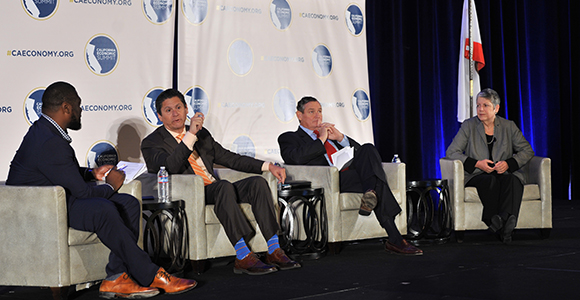
Higher education conversation lead by Ryan Smith of The Education Trust – West (left) included California Community Colleges Chancellor Eloy Ortiz Oakley, California State University Chancellor Timothy White and University of California President Janet Napolitano (Photo Credit: Violeta Vaqeuiro/CA Fwd).
On day two of the 2017 California Economic Summit last week, the statewide gathering highlighted higher education as an important component to Elevate California, a new initiative to restore upward mobility in the state. And, to top it all off, the location of next year's 2018 Summit was revealed.
Co-presented by CA Fwd and the California Stewardship Network, the Summit convened more than 500 civic, business and community leaders in San Diego.
The day started with a panel of millennial and Next Gen leaders, who discussed how California’s economy and the high cost of living are affecting their peers. They also had advice for the higher education leaders who would later take the stage.
“It’s important to know that we have a college system that doesn’t have room for everybody, even if they qualify,” said State Assembly member Autumn Burke, stressing that access to education should be a high priority. Burke added that many of those are students from disenfranchised communities.
Panelist Sean Bhardwaj, founder and CEO of Aspire 3, suggested that colleges and universities need to teach entrepreneurship across disciplines, while Laura Clark of YIMBY Action urged institutions to make sure college students are registered to vote so they have a voice on issues including funding.
In his appearance at the Summit, gubernatorial candidate and former Los Angeles Mayor Antonio Villaraigosa agreed with Burke. “If we’re going to survive and thrive, we’re going to have to do a better job at growing middle class jobs,” said Villaraigosa, adding that 60 percent of high school kids are Latino and African American, but only 13 percent are go on to a four year college. “We’ve got to address that. We’ll be a million and half down on college graduates by 2025 and a million down in people with specialized skills.”
Another conversation featured leaders from all three of the state's public higher education systems: University of California President Janet Napolitano, California State University Chancellor Timothy White and California Community Colleges Chancellor Eloy Ortiz Oakley.
“When we think about income inequality in our country and California, the single tried and true tactic that has worked over time has been access to higher education in terms of increasing social mobility,” said Napolitano. “When I remind people that 45 percent of the entering class at University of California are first-generation college students, that’s real opportunity that public higher education presents in California.”
When asked about affordability, the leaders emphasized the widespread use of financial aid to cut tuition and fees, but reminded the total cost of education also includes California's high housing and other expenses.
“Many of our students are food insecure & homeless. The entire ecosystem has to be supported,” said Chancellor White.” If we don't make this investment, it's a higher cost if we don't succeed.”
According to Ortiz Oakley, California’s community colleges are looking forward and regionally to create upward mobility and train more skilled workers needed across the state. “We’ve spent a lot of time and fortunately we’ve had the investment over the last several years through the Strong Workforce to take a hard look at the regions of California to really hone in on what the future of jobs within regions is going to look like and begin preparing ourselves to develop curricula for the jobs of today and the future, not the jobs yesterday, which is where we’ve been stuck.”
“We have to understand that we ought to celebrate the diversity of our resources,” said State Treasurer John Chiang, also a candidate for Governor. “It’s all about the people and I believe we have an area that is the magnet that draws people. It’s the idea of what California is, so we can flourish uniquely because of the extraordinary diversity that we have.”
The Summit closed with a commitment to Elevate California by expanding opportunities for skilled workers, improving communities through alignment between housing, water, transportation and design, and creating one million more median wage and above jobs.
“You cannot sit on the sidelines,” said Oscar Chavez, assistant director at the Sonoma County Department of Human Services, who made the announcement that Sonoma County will be the site of the 2018 California Economic Summit. “This state needs you.”
Read our summary of Day One: 2017 Summit aims to elevate Californians into the middle class

